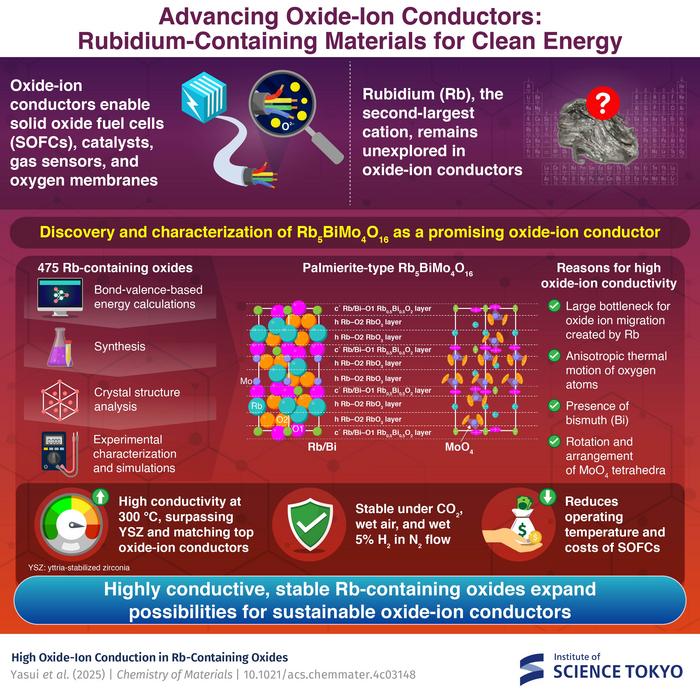
Researchers at the Institute of Science Tokyo have made exciting strides in the development of new oxide-ion conductors, with a particular focus on rubidium (Rb). Their pioneering work has led to the discovery of a new rubidium-containing oxide-ion conductor, Rb₅BiMo₄O₁₆, which boasts impressive conductivity levels that could revolutionize clean energy technologies. Through a blend of computational screening and meticulous experimentation, the team has demonstrated how the unique properties of rubidium can enhance the performance of oxide-ion conductors, a critical component in the energy transition towards sustainable fuels.
Oxide-ion conductors are critical in the realm of solid oxide fuel cells (SOFCs), which have the ability to operate on a range of fuels including hydrogen, natural gas, and biogas. This versatility makes them invaluable as the world shifts towards a hydrogen economy. Despite their potential, SOFCs face challenges relating to cost, durability, and high operating temperatures, which necessitates the search for improved oxide-ion conductors. The innovation brought forth by the Institute of Science Tokyo’s research on rubidium could play a significant role in overcoming these hurdles, marking a considerable breakthrough in energy efficiency.
The research project, headed by Professor Masatomo Yashima, highlights the expansive possibilities of using Rb-based materials in oxide-ion conduction. Historically, the electricity conducting capabilities of oxide-ion conductors have been limited, with notable materials like yttria-stabilized zirconia setting the benchmark. However, the introduction of Rb₅BiMo₄O₁₆ shakes up the field with astonishing conductivity measurements, which are not only considerably higher than conventional standards but also exhibit potential for high-temperature stability.
Rubidium, the second-largest cation after cesium, promises to create oxides with expanded lattice structures. The research team employed an extensive computational screening process on 475 different rubidium-containing oxides, utilizing bond-valence-based energy calculations to pinpoint optimal candidates. Among these, the mineral palmierite’s structure showed promising traits, indicated by its relatively low energy barrier for oxide-ion migration—a significant factor in conductivity.
When turning theory into practice, the Yashima-led team synthesized Rb₅BiMo₄O₁₆ and subjected it to a battery of rigorous experimental tests, including conductivity assessments, stability evaluations under various environmental conditions, and detailed structural analyses. These experiments revealed the underlying mechanisms that amplify oxide-ion conductivity, shedding light on the role of the cation’s size, the molecular architecture, and the thermal dynamics of the material itself.
Remarkably, Rb₅BiMo₄O₁₆ displayed a high oxide-ion conductivity of 0.14 mS/cm at 300°C—an achievement notably 29 times higher than that of traditional yttria-stabilized zirconia. The favorable properties are attributed to several interrelated factors, chiefly the large rubidium ions that lower the activation energy for oxide-ion flow, coupled with the dynamic arrangement of MoO₄ tetrahedra within the crystal lattice, which enhances the lattice flexibility.
Moreover, this new oxide-ion conductor has demonstrated excellent thermal stability, maintaining performance across varying conditions including exposure to CO₂, humid air, and even wet hydrogen atmospheres. Such stability is vital for practical applications in fuel cells, lending further credence to the material’s potential in revolutionary energy systems that could lower operational costs and temperatures.
The versatility of Rb₅BiMo₄O₁₆ opens doors for future research in oxide-ion conductors and other related technologies such as gas sensors, oxygen membranes, and advanced catalysts. As the global community pivots towards sustainable and renewable energy sources, innovations like these will be fundamental in rethinking how energy is produced, stored, and consumed.
The impact of this research transcends academic inquiry, as it aligns with broader societal goals related to energy sustainability and environmental responsibility. By addressing the challenges afflicting current fuel cell technologies, rubidium-containing oxides could initiate a new chapter in clean energy solutions, propelling advancements in practical applications aimed at reducing the environmental footprint.
Furthermore, as the scientific community delves deeper into the characteristics of Rb and its compounds, the development of novel oxide-ion conductors may lead to significant discoveries, yielding materials that not only surpass existing benchmarks but also pave the way for unforeseen innovations. The drive for efficiency, coupled with the quest for lower operational costs, positions this research at the forefront of technological advancements in energy-related fields.
In conclusion, the work done by the Institute of Science Tokyo is a compelling example of how targeted research efforts can yield transformative materials that hold the potential to reshape industries and contribute to a more sustainable energy future. As the implications of their findings ripple through scientific and engineering communities, a clearer path emerges toward achieving the ambitious goals of energy revolution and sustainable development.
Subject of Research: High-Performance Oxide-Ion Conductors
Article Title: Advancing Oxide-Ion Conductors: Rubidium-Containing Materials for Clean Energy
News Publication Date: February 2, 2025
Web References: Chemistry of Materials DOI
References: Journal of Chemistry of Materials
Image Credits: Institute of Science Tokyo
Keywords
Oxide-ion conductors
Rubidium oxides
Clean energy technologies
Solid oxide fuel cells
High conductivity materials
Energy sustainability
Advanced materials science
Thermal stability in materials
Ionic conductivity
Renewable energy solutions
Sustainability in energy transition
Fuel cell technology
Tags: challenges in solid oxide fuel cellscomputational screening in material scienceenergy transition towards hydrogen economyenhancing oxide-ion conductor performancehigh-performance oxide-ion conductorsinnovative materials for clean energy.Institute of Science Tokyo researchProfessor Masatomo Yashima contributionsRb₅BiMo₄O₁₆ conductivity breakthroughsrubidium integration in energy technologiessolid oxide fuel cells advancementssustainable fuel solutions





